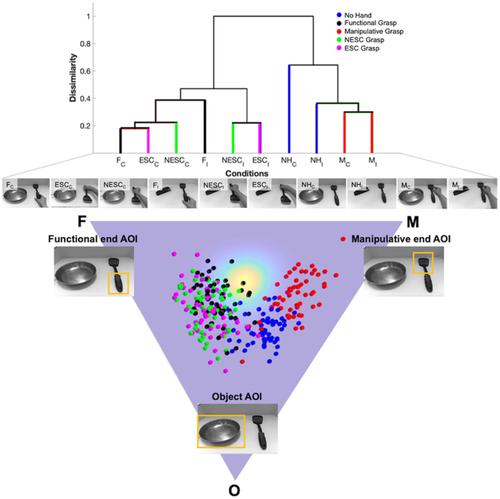当前位置:
X-MOL 学术
›
Eur. J. Nerosci.
›
论文详情
Our official English website, www.x-mol.net, welcomes your feedback! (Note: you will need to create a separate account there.)
Flexible constraint hierarchy during the visual encoding of tool-object interactions
European Journal of Neroscience ( IF 3.4 ) Pub Date : 2021-09-15 , DOI: 10.1111/ejn.15460 Kristel Yu Tiamco Bayani 1 , Nikhilesh Natraj 1, 2 , Mary Kate Gale 1 , Danielle Temples 1 , Neel Atawala 1 , Lewis A Wheaton 1
European Journal of Neroscience ( IF 3.4 ) Pub Date : 2021-09-15 , DOI: 10.1111/ejn.15460 Kristel Yu Tiamco Bayani 1 , Nikhilesh Natraj 1, 2 , Mary Kate Gale 1 , Danielle Temples 1 , Neel Atawala 1 , Lewis A Wheaton 1
Affiliation

|
Tools and objects are associated with numerous action possibilities that are reduced depending on the task-related internal and external constraints presented to the observer. Action hierarchies propose that goals represent higher levels of the hierarchy while kinematic patterns represent lower levels of the hierarchy. Prior work suggests that tool-object perception is heavily influenced by grasp and action context. The current study sought to evaluate whether the presence of action hierarchy can be perceptually identified using eye tracking during tool-object observation. We hypothesize that gaze patterns will reveal a perceptual hierarchy based on the observed task context and grasp constraints. Participants viewed tool-objects scenes with two types of constraints: task-context and grasp constraints. Task-context constraints consisted of correct (e.g., frying pan-spatula) and incorrect tool-object pairings (e.g., stapler-spatula). Grasp constraints involved modified tool orientations, which requires participants to understand how initially awkward grasp postures can help achieve the task. The visual scene contained three areas of interests (AOIs): the object, the functional tool-end (e.g., spoon handle) and the manipulative tool-end (e.g., spoon bowl). Results revealed two distinct processes based on stimuli constraints. Goal-oriented encoding, the attentional bias towards the object and manipulative tool-end, was demonstrated when grasp did not lead to meaningful tool-use. In images where grasp postures were critical to action performance, attentional bias was primarily between the object and functional tool-end, which suggests means-related encoding of the graspable properties of the object. This study expands from previous work and demonstrates a flexible constraint hierarchy depending on the observed task constraints.
中文翻译:

工具对象交互视觉编码过程中灵活的约束层次结构
工具和对象与许多行动可能性相关联,这些行动可能性根据呈现给观察者的与任务相关的内部和外部约束而减少。动作层次结构建议目标代表层次结构的更高级别,而运动模式代表层次结构的较低级别。先前的工作表明,工具对象的感知在很大程度上受到抓握和动作上下文的影响。目前的研究试图评估是否可以在工具对象观察期间使用眼动追踪来感知识别动作层次结构的存在。我们假设凝视模式将揭示基于观察到的任务上下文和抓取约束的感知层次结构。参与者查看具有两种类型约束的工具对象场景:任务上下文和抓取约束。任务上下文约束包括正确的(例如,煎锅-抹刀)和不正确的工具-对象配对(例如,订书机-抹刀)。抓握约束涉及修改工具方向,这要求参与者了解最初尴尬的抓握姿势如何帮助完成任务。视觉场景包含三个兴趣区 (AOI):对象、功能性工具端(例如勺柄)和可操作工具端(例如勺碗)。结果揭示了基于刺激约束的两个不同的过程。当掌握不能导致有意义的工具使用时,就证明了面向目标的编码,即对对象和操纵工具端的注意力偏见。在抓握姿势对动作表现至关重要的图像中,注意力偏差主要在对象和功能工具端之间,这表明对象的可抓取属性的手段相关编码。这项研究扩展了以前的工作,并根据观察到的任务约束展示了灵活的约束层次结构。
更新日期:2021-10-20
中文翻译:

工具对象交互视觉编码过程中灵活的约束层次结构
工具和对象与许多行动可能性相关联,这些行动可能性根据呈现给观察者的与任务相关的内部和外部约束而减少。动作层次结构建议目标代表层次结构的更高级别,而运动模式代表层次结构的较低级别。先前的工作表明,工具对象的感知在很大程度上受到抓握和动作上下文的影响。目前的研究试图评估是否可以在工具对象观察期间使用眼动追踪来感知识别动作层次结构的存在。我们假设凝视模式将揭示基于观察到的任务上下文和抓取约束的感知层次结构。参与者查看具有两种类型约束的工具对象场景:任务上下文和抓取约束。任务上下文约束包括正确的(例如,煎锅-抹刀)和不正确的工具-对象配对(例如,订书机-抹刀)。抓握约束涉及修改工具方向,这要求参与者了解最初尴尬的抓握姿势如何帮助完成任务。视觉场景包含三个兴趣区 (AOI):对象、功能性工具端(例如勺柄)和可操作工具端(例如勺碗)。结果揭示了基于刺激约束的两个不同的过程。当掌握不能导致有意义的工具使用时,就证明了面向目标的编码,即对对象和操纵工具端的注意力偏见。在抓握姿势对动作表现至关重要的图像中,注意力偏差主要在对象和功能工具端之间,这表明对象的可抓取属性的手段相关编码。这项研究扩展了以前的工作,并根据观察到的任务约束展示了灵活的约束层次结构。


























 京公网安备 11010802027423号
京公网安备 11010802027423号